Woolworths: In-depth Analysis of Retail Business Performance
VerifiedAdded on 2020/04/07
|19
|4695
|473
Report
AI Summary
This report presents an in-depth analysis of Woolworths, a leading retail company, examining its financial and non-financial factors to assess operational efficiency and future viability. The analysis employs various tools, including SWOT, PESTLE, ratio analysis, and Porter's Five Forces, to evaluate the company's performance. The report covers Woolworths' business operations, investment and financing activities, and financial reporting practices, alongside an overview of the retail industry's size, growth, supply chain, and key players. It further explores critical success factors, key threats, legal and environmental regulations, and provides PEST and SWOT analyses. The report also assesses business risks, industry developments, and management and governance aspects, including communication of ethical values and organizational structure. The conclusion highlights the company's compliance with regulatory and accounting aspects, supporting its sustainable future. The report is a comprehensive assessment of Woolworths' strengths, weaknesses, opportunities, and threats within the competitive retail landscape.
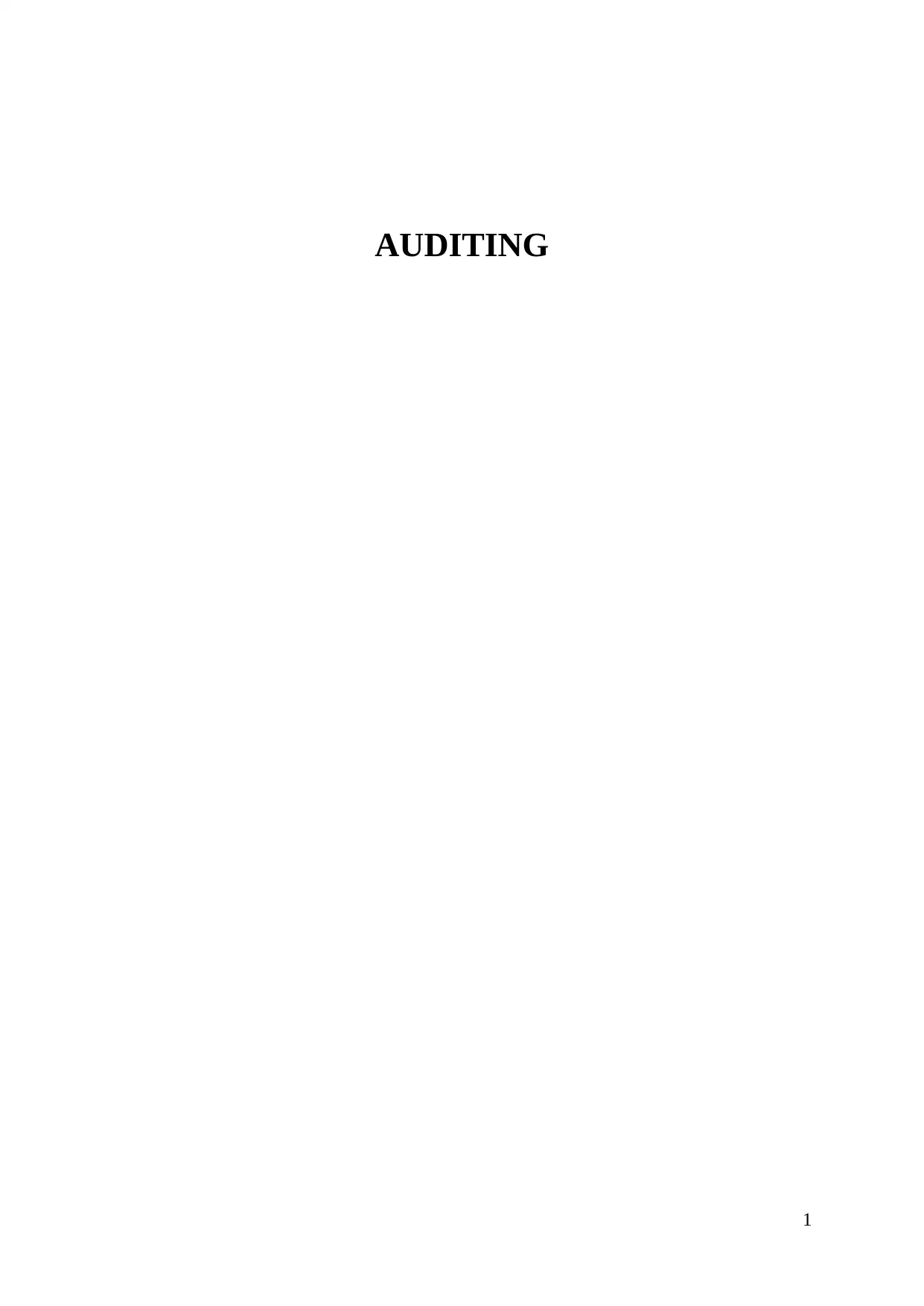
AUDITING
1
1
Paraphrase This Document
Need a fresh take? Get an instant paraphrase of this document with our AI Paraphraser
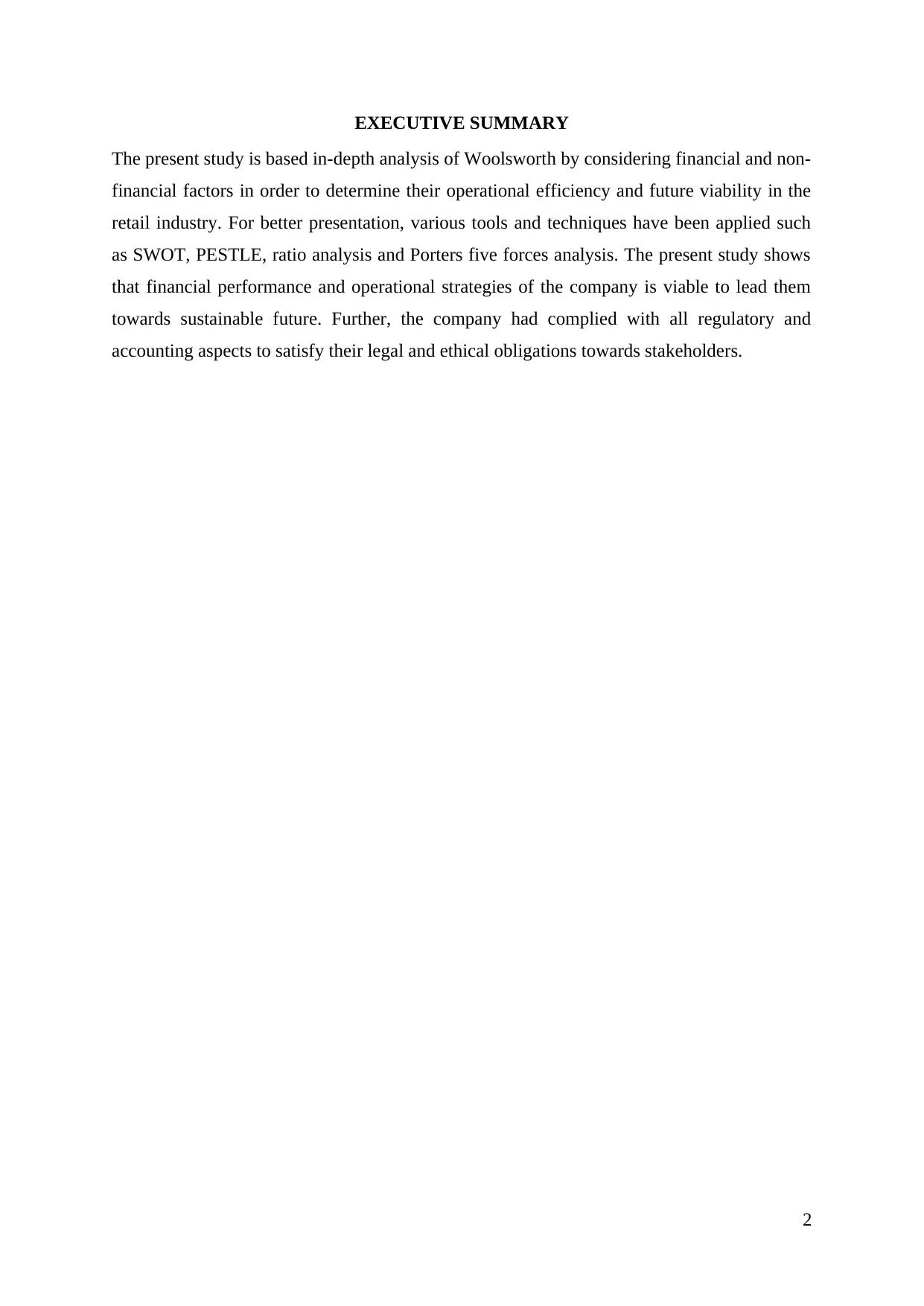
EXECUTIVE SUMMARY
The present study is based in-depth analysis of Woolsworth by considering financial and non-
financial factors in order to determine their operational efficiency and future viability in the
retail industry. For better presentation, various tools and techniques have been applied such
as SWOT, PESTLE, ratio analysis and Porters five forces analysis. The present study shows
that financial performance and operational strategies of the company is viable to lead them
towards sustainable future. Further, the company had complied with all regulatory and
accounting aspects to satisfy their legal and ethical obligations towards stakeholders.
2
The present study is based in-depth analysis of Woolsworth by considering financial and non-
financial factors in order to determine their operational efficiency and future viability in the
retail industry. For better presentation, various tools and techniques have been applied such
as SWOT, PESTLE, ratio analysis and Porters five forces analysis. The present study shows
that financial performance and operational strategies of the company is viable to lead them
towards sustainable future. Further, the company had complied with all regulatory and
accounting aspects to satisfy their legal and ethical obligations towards stakeholders.
2
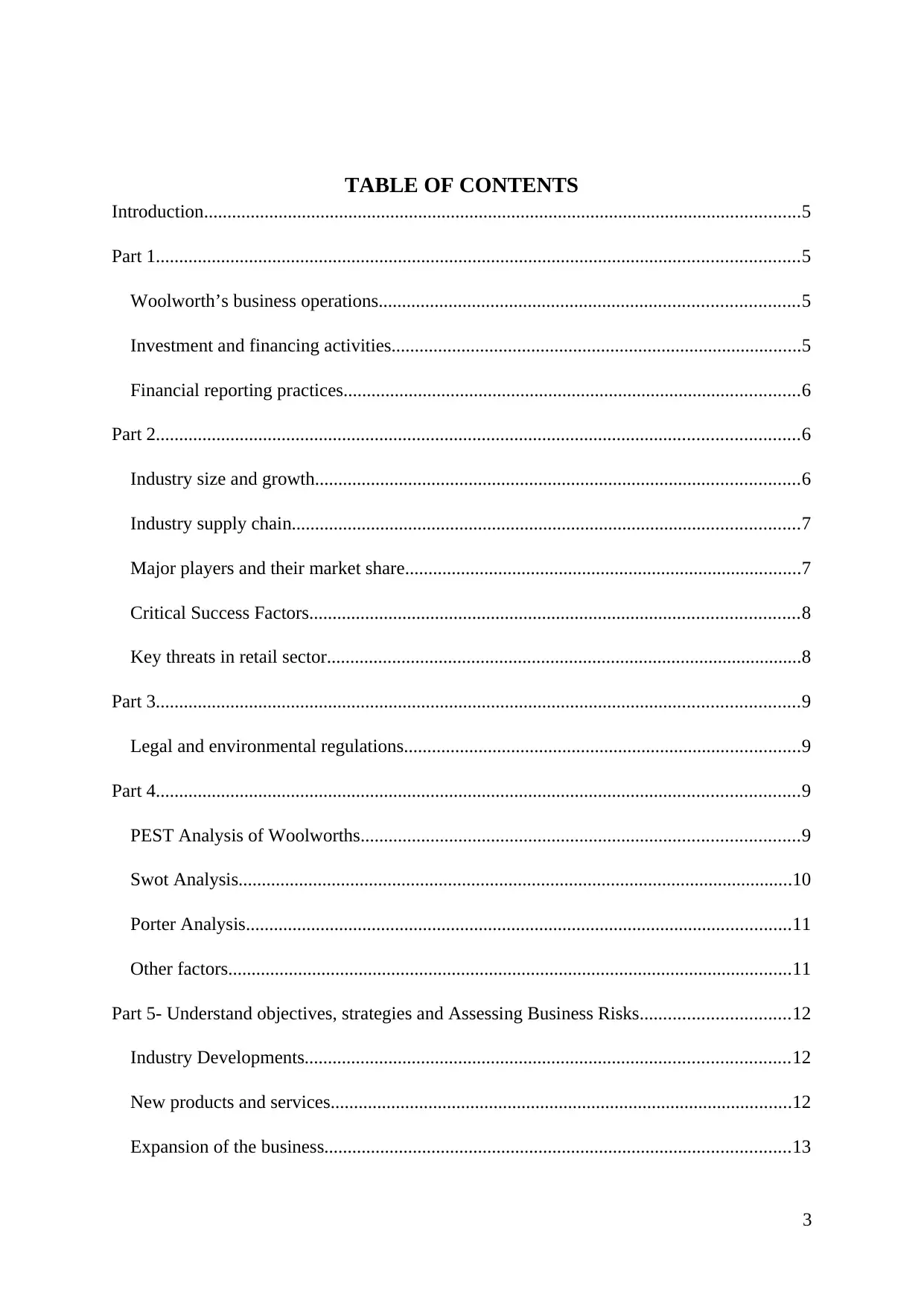
TABLE OF CONTENTS
Introduction................................................................................................................................5
Part 1..........................................................................................................................................5
Woolworth’s business operations..........................................................................................5
Investment and financing activities........................................................................................5
Financial reporting practices..................................................................................................6
Part 2..........................................................................................................................................6
Industry size and growth........................................................................................................6
Industry supply chain.............................................................................................................7
Major players and their market share.....................................................................................7
Critical Success Factors.........................................................................................................8
Key threats in retail sector......................................................................................................8
Part 3..........................................................................................................................................9
Legal and environmental regulations.....................................................................................9
Part 4..........................................................................................................................................9
PEST Analysis of Woolworths..............................................................................................9
Swot Analysis.......................................................................................................................10
Porter Analysis.....................................................................................................................11
Other factors.........................................................................................................................11
Part 5- Understand objectives, strategies and Assessing Business Risks................................12
Industry Developments........................................................................................................12
New products and services...................................................................................................12
Expansion of the business....................................................................................................13
3
Introduction................................................................................................................................5
Part 1..........................................................................................................................................5
Woolworth’s business operations..........................................................................................5
Investment and financing activities........................................................................................5
Financial reporting practices..................................................................................................6
Part 2..........................................................................................................................................6
Industry size and growth........................................................................................................6
Industry supply chain.............................................................................................................7
Major players and their market share.....................................................................................7
Critical Success Factors.........................................................................................................8
Key threats in retail sector......................................................................................................8
Part 3..........................................................................................................................................9
Legal and environmental regulations.....................................................................................9
Part 4..........................................................................................................................................9
PEST Analysis of Woolworths..............................................................................................9
Swot Analysis.......................................................................................................................10
Porter Analysis.....................................................................................................................11
Other factors.........................................................................................................................11
Part 5- Understand objectives, strategies and Assessing Business Risks................................12
Industry Developments........................................................................................................12
New products and services...................................................................................................12
Expansion of the business....................................................................................................13
3
⊘ This is a preview!⊘
Do you want full access?
Subscribe today to unlock all pages.

Trusted by 1+ million students worldwide
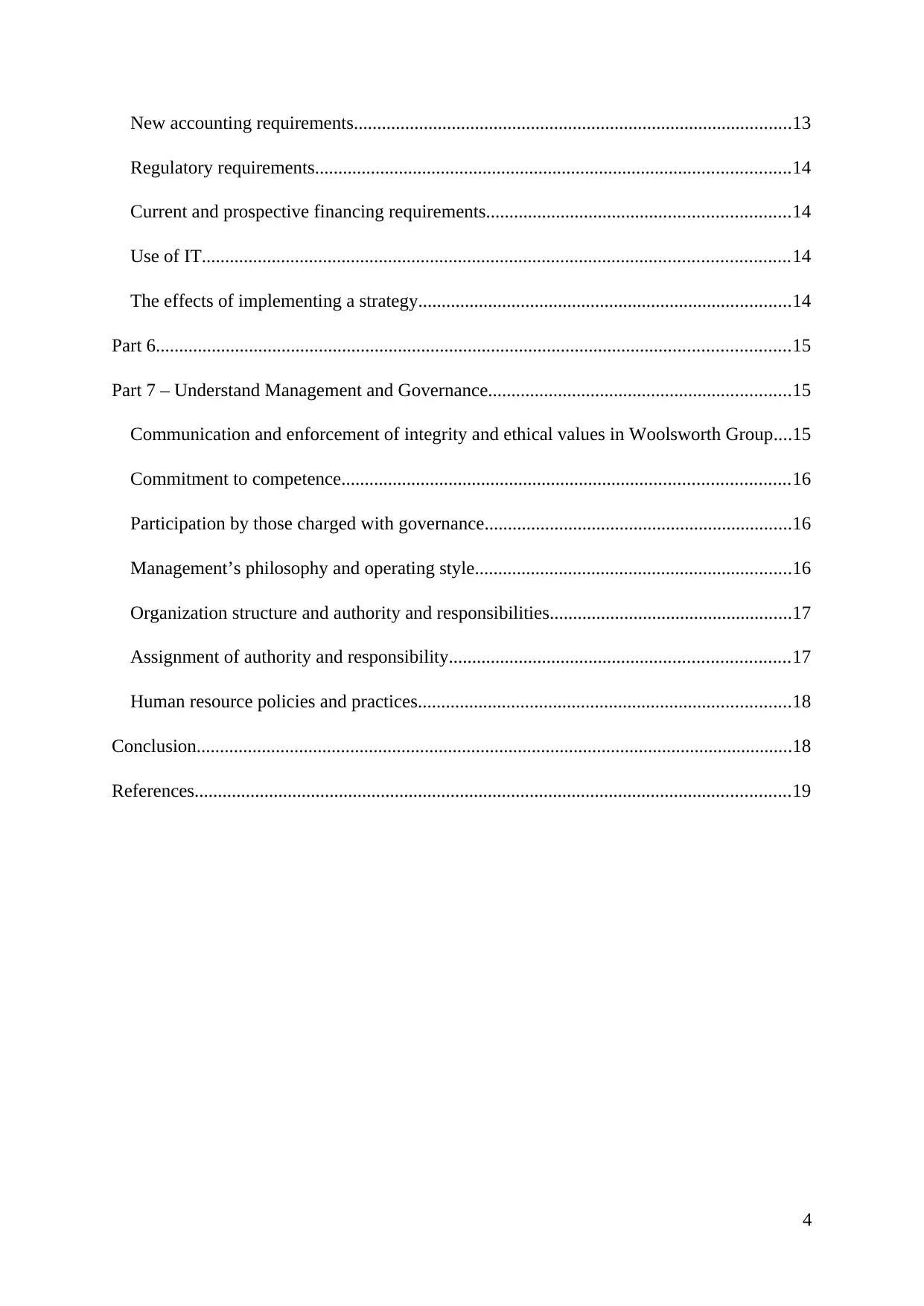
New accounting requirements..............................................................................................13
Regulatory requirements......................................................................................................14
Current and prospective financing requirements.................................................................14
Use of IT..............................................................................................................................14
The effects of implementing a strategy................................................................................14
Part 6........................................................................................................................................15
Part 7 – Understand Management and Governance.................................................................15
Communication and enforcement of integrity and ethical values in Woolsworth Group....15
Commitment to competence................................................................................................16
Participation by those charged with governance..................................................................16
Management’s philosophy and operating style....................................................................16
Organization structure and authority and responsibilities....................................................17
Assignment of authority and responsibility.........................................................................17
Human resource policies and practices................................................................................18
Conclusion................................................................................................................................18
References................................................................................................................................19
4
Regulatory requirements......................................................................................................14
Current and prospective financing requirements.................................................................14
Use of IT..............................................................................................................................14
The effects of implementing a strategy................................................................................14
Part 6........................................................................................................................................15
Part 7 – Understand Management and Governance.................................................................15
Communication and enforcement of integrity and ethical values in Woolsworth Group....15
Commitment to competence................................................................................................16
Participation by those charged with governance..................................................................16
Management’s philosophy and operating style....................................................................16
Organization structure and authority and responsibilities....................................................17
Assignment of authority and responsibility.........................................................................17
Human resource policies and practices................................................................................18
Conclusion................................................................................................................................18
References................................................................................................................................19
4
Paraphrase This Document
Need a fresh take? Get an instant paraphrase of this document with our AI Paraphraser
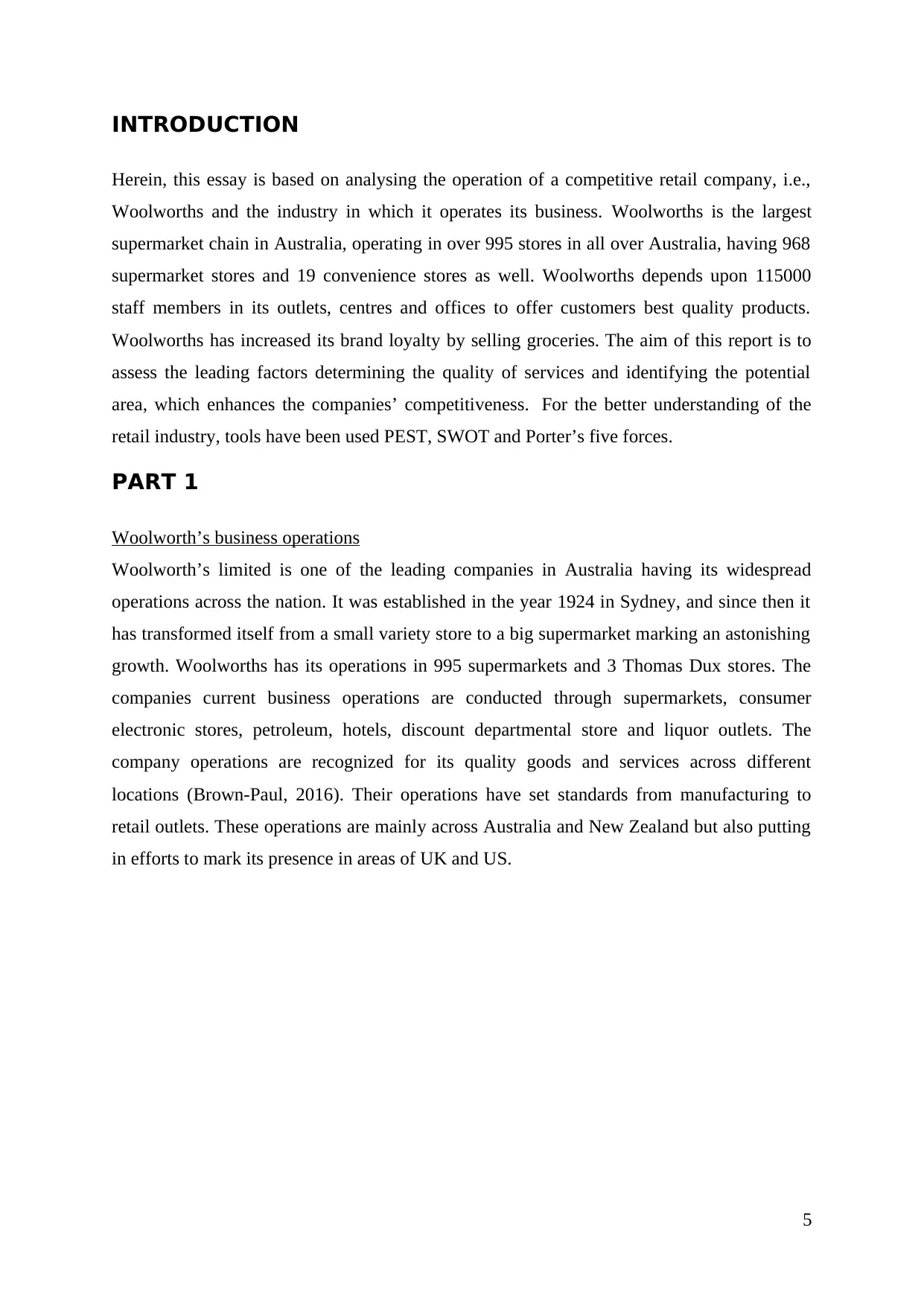
INTRODUCTION
Herein, this essay is based on analysing the operation of a competitive retail company, i.e.,
Woolworths and the industry in which it operates its business. Woolworths is the largest
supermarket chain in Australia, operating in over 995 stores in all over Australia, having 968
supermarket stores and 19 convenience stores as well. Woolworths depends upon 115000
staff members in its outlets, centres and offices to offer customers best quality products.
Woolworths has increased its brand loyalty by selling groceries. The aim of this report is to
assess the leading factors determining the quality of services and identifying the potential
area, which enhances the companies’ competitiveness. For the better understanding of the
retail industry, tools have been used PEST, SWOT and Porter’s five forces.
PART 1
Woolworth’s business operations
Woolworth’s limited is one of the leading companies in Australia having its widespread
operations across the nation. It was established in the year 1924 in Sydney, and since then it
has transformed itself from a small variety store to a big supermarket marking an astonishing
growth. Woolworths has its operations in 995 supermarkets and 3 Thomas Dux stores. The
companies current business operations are conducted through supermarkets, consumer
electronic stores, petroleum, hotels, discount departmental store and liquor outlets. The
company operations are recognized for its quality goods and services across different
locations (Brown-Paul, 2016). Their operations have set standards from manufacturing to
retail outlets. These operations are mainly across Australia and New Zealand but also putting
in efforts to mark its presence in areas of UK and US.
5
Herein, this essay is based on analysing the operation of a competitive retail company, i.e.,
Woolworths and the industry in which it operates its business. Woolworths is the largest
supermarket chain in Australia, operating in over 995 stores in all over Australia, having 968
supermarket stores and 19 convenience stores as well. Woolworths depends upon 115000
staff members in its outlets, centres and offices to offer customers best quality products.
Woolworths has increased its brand loyalty by selling groceries. The aim of this report is to
assess the leading factors determining the quality of services and identifying the potential
area, which enhances the companies’ competitiveness. For the better understanding of the
retail industry, tools have been used PEST, SWOT and Porter’s five forces.
PART 1
Woolworth’s business operations
Woolworth’s limited is one of the leading companies in Australia having its widespread
operations across the nation. It was established in the year 1924 in Sydney, and since then it
has transformed itself from a small variety store to a big supermarket marking an astonishing
growth. Woolworths has its operations in 995 supermarkets and 3 Thomas Dux stores. The
companies current business operations are conducted through supermarkets, consumer
electronic stores, petroleum, hotels, discount departmental store and liquor outlets. The
company operations are recognized for its quality goods and services across different
locations (Brown-Paul, 2016). Their operations have set standards from manufacturing to
retail outlets. These operations are mainly across Australia and New Zealand but also putting
in efforts to mark its presence in areas of UK and US.
5
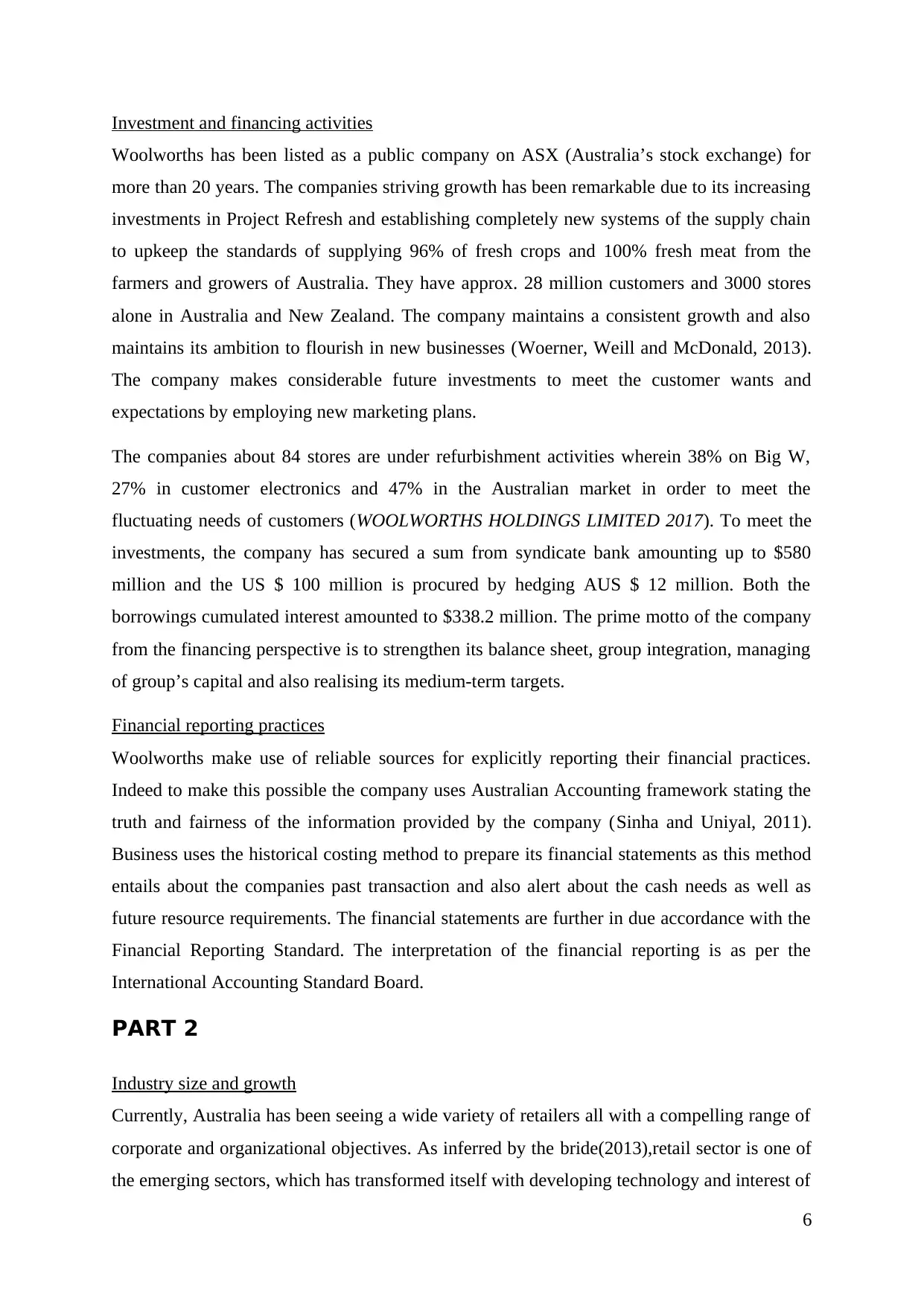
Investment and financing activities
Woolworths has been listed as a public company on ASX (Australia’s stock exchange) for
more than 20 years. The companies striving growth has been remarkable due to its increasing
investments in Project Refresh and establishing completely new systems of the supply chain
to upkeep the standards of supplying 96% of fresh crops and 100% fresh meat from the
farmers and growers of Australia. They have approx. 28 million customers and 3000 stores
alone in Australia and New Zealand. The company maintains a consistent growth and also
maintains its ambition to flourish in new businesses (Woerner, Weill and McDonald, 2013).
The company makes considerable future investments to meet the customer wants and
expectations by employing new marketing plans.
The companies about 84 stores are under refurbishment activities wherein 38% on Big W,
27% in customer electronics and 47% in the Australian market in order to meet the
fluctuating needs of customers (WOOLWORTHS HOLDINGS LIMITED 2017). To meet the
investments, the company has secured a sum from syndicate bank amounting up to $580
million and the US $ 100 million is procured by hedging AUS $ 12 million. Both the
borrowings cumulated interest amounted to $338.2 million. The prime motto of the company
from the financing perspective is to strengthen its balance sheet, group integration, managing
of group’s capital and also realising its medium-term targets.
Financial reporting practices
Woolworths make use of reliable sources for explicitly reporting their financial practices.
Indeed to make this possible the company uses Australian Accounting framework stating the
truth and fairness of the information provided by the company (Sinha and Uniyal, 2011).
Business uses the historical costing method to prepare its financial statements as this method
entails about the companies past transaction and also alert about the cash needs as well as
future resource requirements. The financial statements are further in due accordance with the
Financial Reporting Standard. The interpretation of the financial reporting is as per the
International Accounting Standard Board.
PART 2
Industry size and growth
Currently, Australia has been seeing a wide variety of retailers all with a compelling range of
corporate and organizational objectives. As inferred by the bride(2013),retail sector is one of
the emerging sectors, which has transformed itself with developing technology and interest of
6
Woolworths has been listed as a public company on ASX (Australia’s stock exchange) for
more than 20 years. The companies striving growth has been remarkable due to its increasing
investments in Project Refresh and establishing completely new systems of the supply chain
to upkeep the standards of supplying 96% of fresh crops and 100% fresh meat from the
farmers and growers of Australia. They have approx. 28 million customers and 3000 stores
alone in Australia and New Zealand. The company maintains a consistent growth and also
maintains its ambition to flourish in new businesses (Woerner, Weill and McDonald, 2013).
The company makes considerable future investments to meet the customer wants and
expectations by employing new marketing plans.
The companies about 84 stores are under refurbishment activities wherein 38% on Big W,
27% in customer electronics and 47% in the Australian market in order to meet the
fluctuating needs of customers (WOOLWORTHS HOLDINGS LIMITED 2017). To meet the
investments, the company has secured a sum from syndicate bank amounting up to $580
million and the US $ 100 million is procured by hedging AUS $ 12 million. Both the
borrowings cumulated interest amounted to $338.2 million. The prime motto of the company
from the financing perspective is to strengthen its balance sheet, group integration, managing
of group’s capital and also realising its medium-term targets.
Financial reporting practices
Woolworths make use of reliable sources for explicitly reporting their financial practices.
Indeed to make this possible the company uses Australian Accounting framework stating the
truth and fairness of the information provided by the company (Sinha and Uniyal, 2011).
Business uses the historical costing method to prepare its financial statements as this method
entails about the companies past transaction and also alert about the cash needs as well as
future resource requirements. The financial statements are further in due accordance with the
Financial Reporting Standard. The interpretation of the financial reporting is as per the
International Accounting Standard Board.
PART 2
Industry size and growth
Currently, Australia has been seeing a wide variety of retailers all with a compelling range of
corporate and organizational objectives. As inferred by the bride(2013),retail sector is one of
the emerging sectors, which has transformed itself with developing technology and interest of
6
⊘ This is a preview!⊘
Do you want full access?
Subscribe today to unlock all pages.

Trusted by 1+ million students worldwide
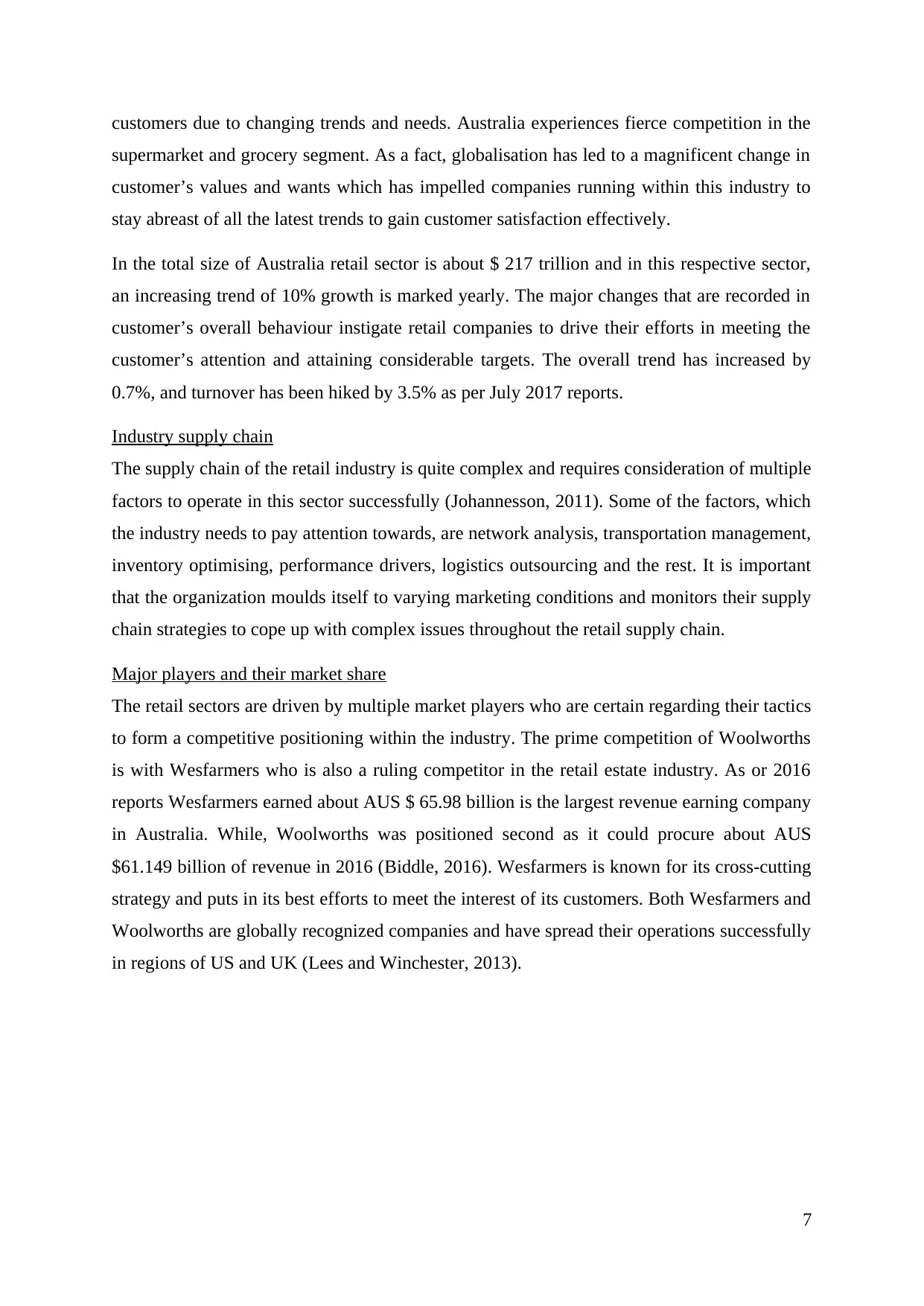
customers due to changing trends and needs. Australia experiences fierce competition in the
supermarket and grocery segment. As a fact, globalisation has led to a magnificent change in
customer’s values and wants which has impelled companies running within this industry to
stay abreast of all the latest trends to gain customer satisfaction effectively.
In the total size of Australia retail sector is about $ 217 trillion and in this respective sector,
an increasing trend of 10% growth is marked yearly. The major changes that are recorded in
customer’s overall behaviour instigate retail companies to drive their efforts in meeting the
customer’s attention and attaining considerable targets. The overall trend has increased by
0.7%, and turnover has been hiked by 3.5% as per July 2017 reports.
Industry supply chain
The supply chain of the retail industry is quite complex and requires consideration of multiple
factors to operate in this sector successfully (Johannesson, 2011). Some of the factors, which
the industry needs to pay attention towards, are network analysis, transportation management,
inventory optimising, performance drivers, logistics outsourcing and the rest. It is important
that the organization moulds itself to varying marketing conditions and monitors their supply
chain strategies to cope up with complex issues throughout the retail supply chain.
Major players and their market share
The retail sectors are driven by multiple market players who are certain regarding their tactics
to form a competitive positioning within the industry. The prime competition of Woolworths
is with Wesfarmers who is also a ruling competitor in the retail estate industry. As or 2016
reports Wesfarmers earned about AUS $ 65.98 billion is the largest revenue earning company
in Australia. While, Woolworths was positioned second as it could procure about AUS
$61.149 billion of revenue in 2016 (Biddle, 2016). Wesfarmers is known for its cross-cutting
strategy and puts in its best efforts to meet the interest of its customers. Both Wesfarmers and
Woolworths are globally recognized companies and have spread their operations successfully
in regions of US and UK (Lees and Winchester, 2013).
7
supermarket and grocery segment. As a fact, globalisation has led to a magnificent change in
customer’s values and wants which has impelled companies running within this industry to
stay abreast of all the latest trends to gain customer satisfaction effectively.
In the total size of Australia retail sector is about $ 217 trillion and in this respective sector,
an increasing trend of 10% growth is marked yearly. The major changes that are recorded in
customer’s overall behaviour instigate retail companies to drive their efforts in meeting the
customer’s attention and attaining considerable targets. The overall trend has increased by
0.7%, and turnover has been hiked by 3.5% as per July 2017 reports.
Industry supply chain
The supply chain of the retail industry is quite complex and requires consideration of multiple
factors to operate in this sector successfully (Johannesson, 2011). Some of the factors, which
the industry needs to pay attention towards, are network analysis, transportation management,
inventory optimising, performance drivers, logistics outsourcing and the rest. It is important
that the organization moulds itself to varying marketing conditions and monitors their supply
chain strategies to cope up with complex issues throughout the retail supply chain.
Major players and their market share
The retail sectors are driven by multiple market players who are certain regarding their tactics
to form a competitive positioning within the industry. The prime competition of Woolworths
is with Wesfarmers who is also a ruling competitor in the retail estate industry. As or 2016
reports Wesfarmers earned about AUS $ 65.98 billion is the largest revenue earning company
in Australia. While, Woolworths was positioned second as it could procure about AUS
$61.149 billion of revenue in 2016 (Biddle, 2016). Wesfarmers is known for its cross-cutting
strategy and puts in its best efforts to meet the interest of its customers. Both Wesfarmers and
Woolworths are globally recognized companies and have spread their operations successfully
in regions of US and UK (Lees and Winchester, 2013).
7
Paraphrase This Document
Need a fresh take? Get an instant paraphrase of this document with our AI Paraphraser
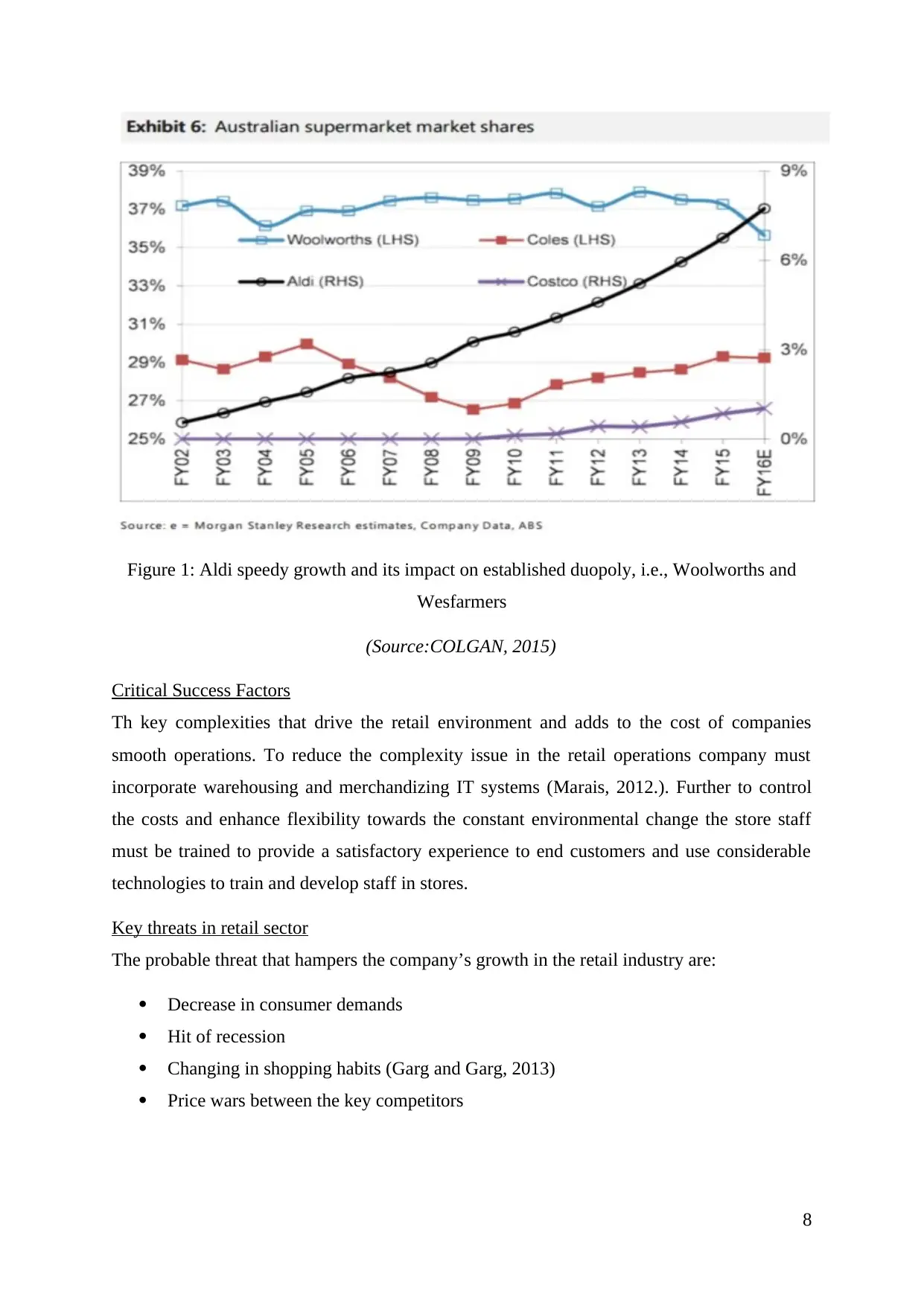
Figure 1: Aldi speedy growth and its impact on established duopoly, i.e., Woolworths and
Wesfarmers
(Source:COLGAN, 2015)
Critical Success Factors
Th key complexities that drive the retail environment and adds to the cost of companies
smooth operations. To reduce the complexity issue in the retail operations company must
incorporate warehousing and merchandizing IT systems (Marais, 2012.). Further to control
the costs and enhance flexibility towards the constant environmental change the store staff
must be trained to provide a satisfactory experience to end customers and use considerable
technologies to train and develop staff in stores.
Key threats in retail sector
The probable threat that hampers the company’s growth in the retail industry are:
Decrease in consumer demands
Hit of recession
Changing in shopping habits (Garg and Garg, 2013)
Price wars between the key competitors
8
Wesfarmers
(Source:COLGAN, 2015)
Critical Success Factors
Th key complexities that drive the retail environment and adds to the cost of companies
smooth operations. To reduce the complexity issue in the retail operations company must
incorporate warehousing and merchandizing IT systems (Marais, 2012.). Further to control
the costs and enhance flexibility towards the constant environmental change the store staff
must be trained to provide a satisfactory experience to end customers and use considerable
technologies to train and develop staff in stores.
Key threats in retail sector
The probable threat that hampers the company’s growth in the retail industry are:
Decrease in consumer demands
Hit of recession
Changing in shopping habits (Garg and Garg, 2013)
Price wars between the key competitors
8
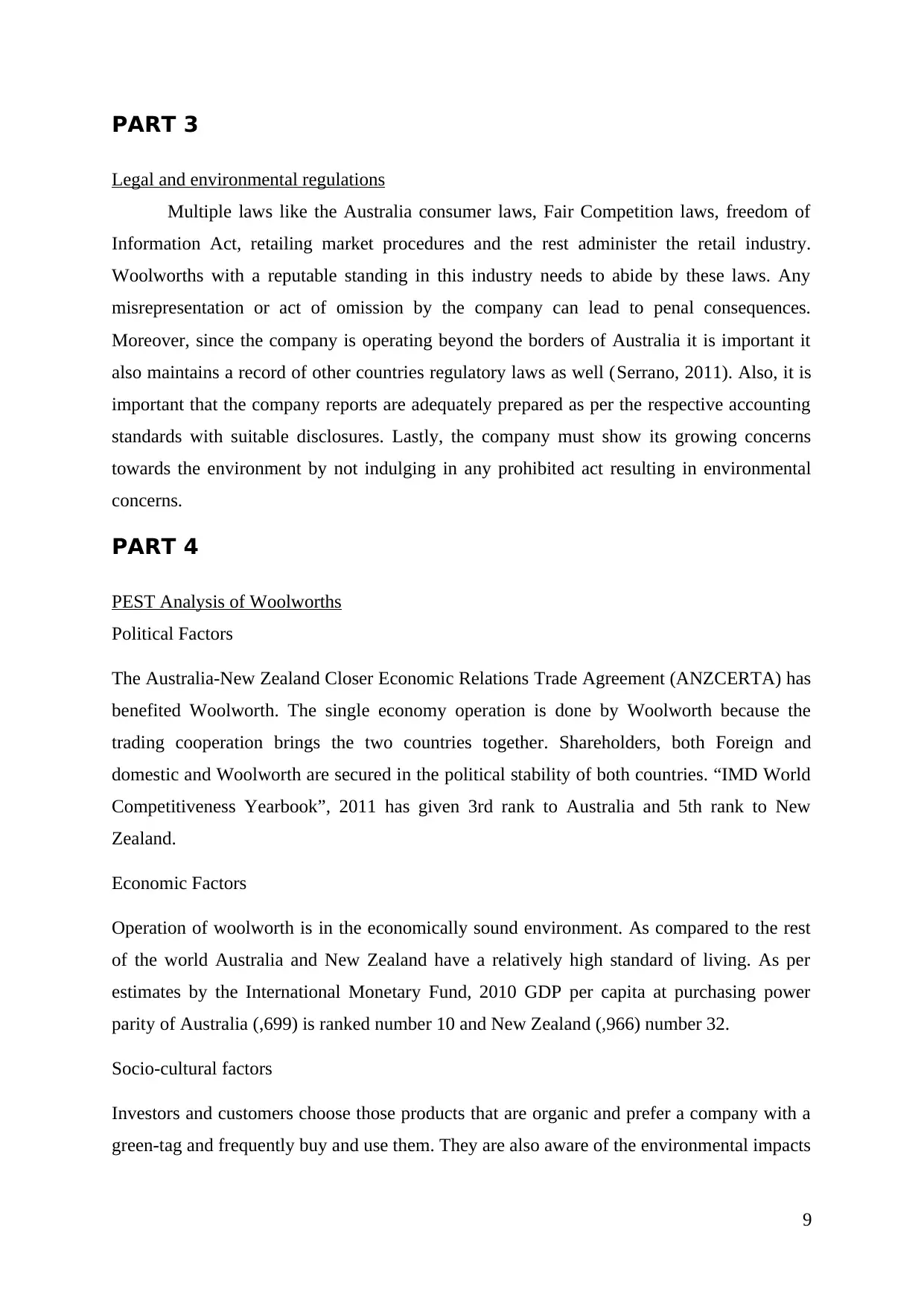
PART 3
Legal and environmental regulations
Multiple laws like the Australia consumer laws, Fair Competition laws, freedom of
Information Act, retailing market procedures and the rest administer the retail industry.
Woolworths with a reputable standing in this industry needs to abide by these laws. Any
misrepresentation or act of omission by the company can lead to penal consequences.
Moreover, since the company is operating beyond the borders of Australia it is important it
also maintains a record of other countries regulatory laws as well (Serrano, 2011). Also, it is
important that the company reports are adequately prepared as per the respective accounting
standards with suitable disclosures. Lastly, the company must show its growing concerns
towards the environment by not indulging in any prohibited act resulting in environmental
concerns.
PART 4
PEST Analysis of Woolworths
Political Factors
The Australia-New Zealand Closer Economic Relations Trade Agreement (ANZCERTA) has
benefited Woolworth. The single economy operation is done by Woolworth because the
trading cooperation brings the two countries together. Shareholders, both Foreign and
domestic and Woolworth are secured in the political stability of both countries. “IMD World
Competitiveness Yearbook”, 2011 has given 3rd rank to Australia and 5th rank to New
Zealand.
Economic Factors
Operation of woolworth is in the economically sound environment. As compared to the rest
of the world Australia and New Zealand have a relatively high standard of living. As per
estimates by the International Monetary Fund, 2010 GDP per capita at purchasing power
parity of Australia (,699) is ranked number 10 and New Zealand (,966) number 32.
Socio-cultural factors
Investors and customers choose those products that are organic and prefer a company with a
green-tag and frequently buy and use them. They are also aware of the environmental impacts
9
Legal and environmental regulations
Multiple laws like the Australia consumer laws, Fair Competition laws, freedom of
Information Act, retailing market procedures and the rest administer the retail industry.
Woolworths with a reputable standing in this industry needs to abide by these laws. Any
misrepresentation or act of omission by the company can lead to penal consequences.
Moreover, since the company is operating beyond the borders of Australia it is important it
also maintains a record of other countries regulatory laws as well (Serrano, 2011). Also, it is
important that the company reports are adequately prepared as per the respective accounting
standards with suitable disclosures. Lastly, the company must show its growing concerns
towards the environment by not indulging in any prohibited act resulting in environmental
concerns.
PART 4
PEST Analysis of Woolworths
Political Factors
The Australia-New Zealand Closer Economic Relations Trade Agreement (ANZCERTA) has
benefited Woolworth. The single economy operation is done by Woolworth because the
trading cooperation brings the two countries together. Shareholders, both Foreign and
domestic and Woolworth are secured in the political stability of both countries. “IMD World
Competitiveness Yearbook”, 2011 has given 3rd rank to Australia and 5th rank to New
Zealand.
Economic Factors
Operation of woolworth is in the economically sound environment. As compared to the rest
of the world Australia and New Zealand have a relatively high standard of living. As per
estimates by the International Monetary Fund, 2010 GDP per capita at purchasing power
parity of Australia (,699) is ranked number 10 and New Zealand (,966) number 32.
Socio-cultural factors
Investors and customers choose those products that are organic and prefer a company with a
green-tag and frequently buy and use them. They are also aware of the environmental impacts
9
⊘ This is a preview!⊘
Do you want full access?
Subscribe today to unlock all pages.

Trusted by 1+ million students worldwide
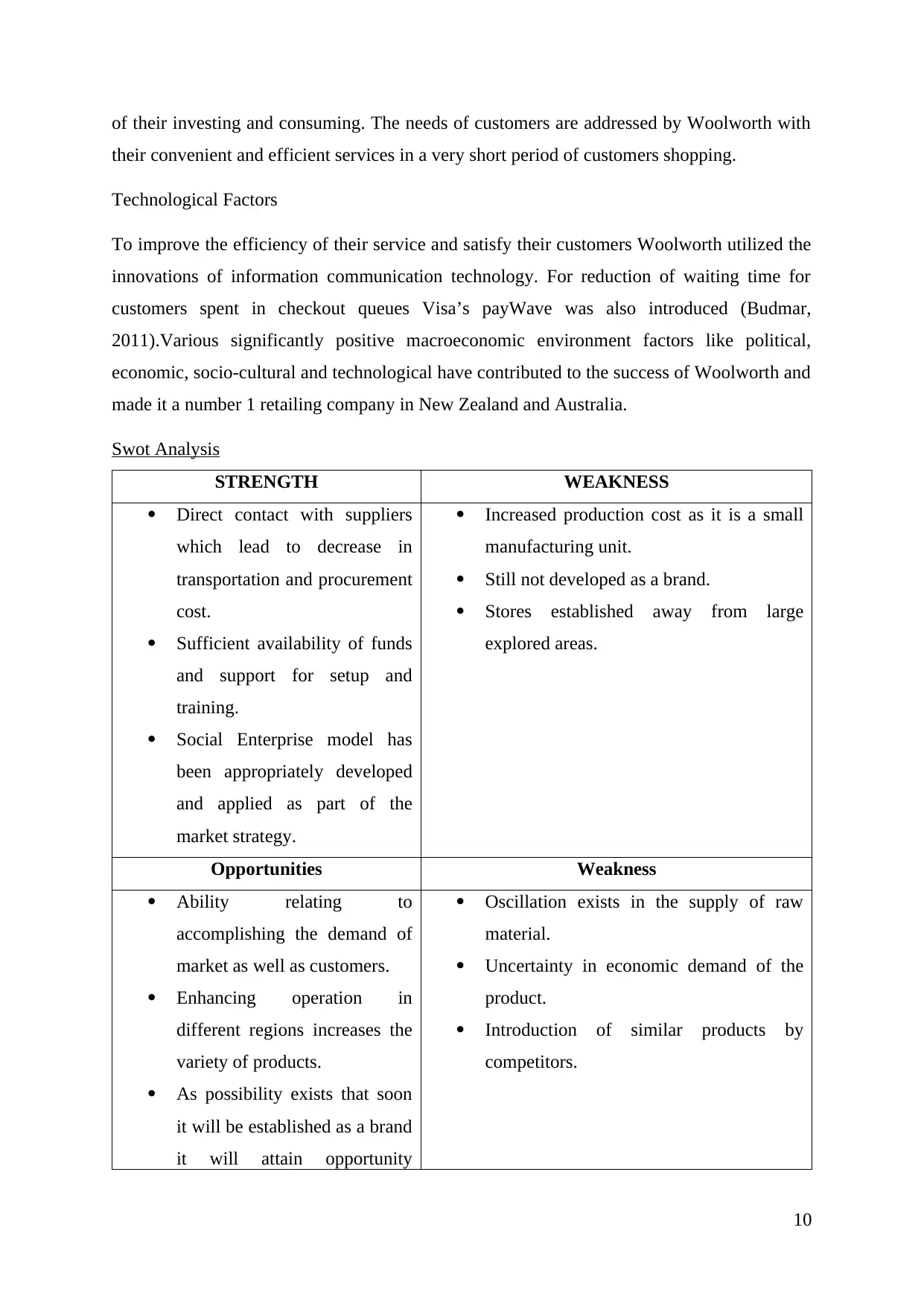
of their investing and consuming. The needs of customers are addressed by Woolworth with
their convenient and efficient services in a very short period of customers shopping.
Technological Factors
To improve the efficiency of their service and satisfy their customers Woolworth utilized the
innovations of information communication technology. For reduction of waiting time for
customers spent in checkout queues Visa’s payWave was also introduced (Budmar,
2011).Various significantly positive macroeconomic environment factors like political,
economic, socio-cultural and technological have contributed to the success of Woolworth and
made it a number 1 retailing company in New Zealand and Australia.
Swot Analysis
STRENGTH WEAKNESS
Direct contact with suppliers
which lead to decrease in
transportation and procurement
cost.
Sufficient availability of funds
and support for setup and
training.
Social Enterprise model has
been appropriately developed
and applied as part of the
market strategy.
Increased production cost as it is a small
manufacturing unit.
Still not developed as a brand.
Stores established away from large
explored areas.
Opportunities Weakness
Ability relating to
accomplishing the demand of
market as well as customers.
Enhancing operation in
different regions increases the
variety of products.
As possibility exists that soon
it will be established as a brand
it will attain opportunity
Oscillation exists in the supply of raw
material.
Uncertainty in economic demand of the
product.
Introduction of similar products by
competitors.
10
their convenient and efficient services in a very short period of customers shopping.
Technological Factors
To improve the efficiency of their service and satisfy their customers Woolworth utilized the
innovations of information communication technology. For reduction of waiting time for
customers spent in checkout queues Visa’s payWave was also introduced (Budmar,
2011).Various significantly positive macroeconomic environment factors like political,
economic, socio-cultural and technological have contributed to the success of Woolworth and
made it a number 1 retailing company in New Zealand and Australia.
Swot Analysis
STRENGTH WEAKNESS
Direct contact with suppliers
which lead to decrease in
transportation and procurement
cost.
Sufficient availability of funds
and support for setup and
training.
Social Enterprise model has
been appropriately developed
and applied as part of the
market strategy.
Increased production cost as it is a small
manufacturing unit.
Still not developed as a brand.
Stores established away from large
explored areas.
Opportunities Weakness
Ability relating to
accomplishing the demand of
market as well as customers.
Enhancing operation in
different regions increases the
variety of products.
As possibility exists that soon
it will be established as a brand
it will attain opportunity
Oscillation exists in the supply of raw
material.
Uncertainty in economic demand of the
product.
Introduction of similar products by
competitors.
10
Paraphrase This Document
Need a fresh take? Get an instant paraphrase of this document with our AI Paraphraser
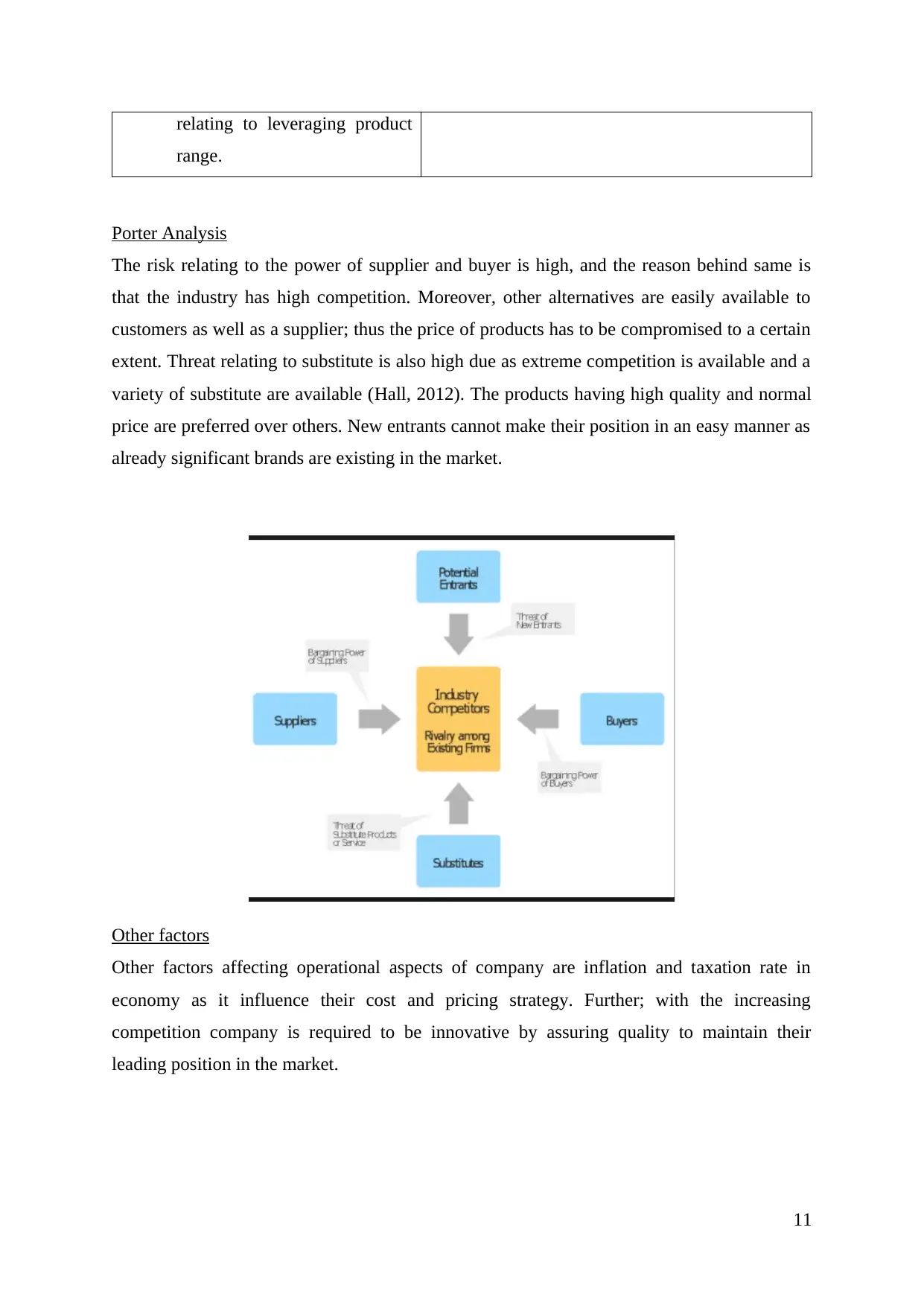
relating to leveraging product
range.
Porter Analysis
The risk relating to the power of supplier and buyer is high, and the reason behind same is
that the industry has high competition. Moreover, other alternatives are easily available to
customers as well as a supplier; thus the price of products has to be compromised to a certain
extent. Threat relating to substitute is also high due as extreme competition is available and a
variety of substitute are available (Hall, 2012). The products having high quality and normal
price are preferred over others. New entrants cannot make their position in an easy manner as
already significant brands are existing in the market.
Other factors
Other factors affecting operational aspects of company are inflation and taxation rate in
economy as it influence their cost and pricing strategy. Further; with the increasing
competition company is required to be innovative by assuring quality to maintain their
leading position in the market.
11
range.
Porter Analysis
The risk relating to the power of supplier and buyer is high, and the reason behind same is
that the industry has high competition. Moreover, other alternatives are easily available to
customers as well as a supplier; thus the price of products has to be compromised to a certain
extent. Threat relating to substitute is also high due as extreme competition is available and a
variety of substitute are available (Hall, 2012). The products having high quality and normal
price are preferred over others. New entrants cannot make their position in an easy manner as
already significant brands are existing in the market.
Other factors
Other factors affecting operational aspects of company are inflation and taxation rate in
economy as it influence their cost and pricing strategy. Further; with the increasing
competition company is required to be innovative by assuring quality to maintain their
leading position in the market.
11
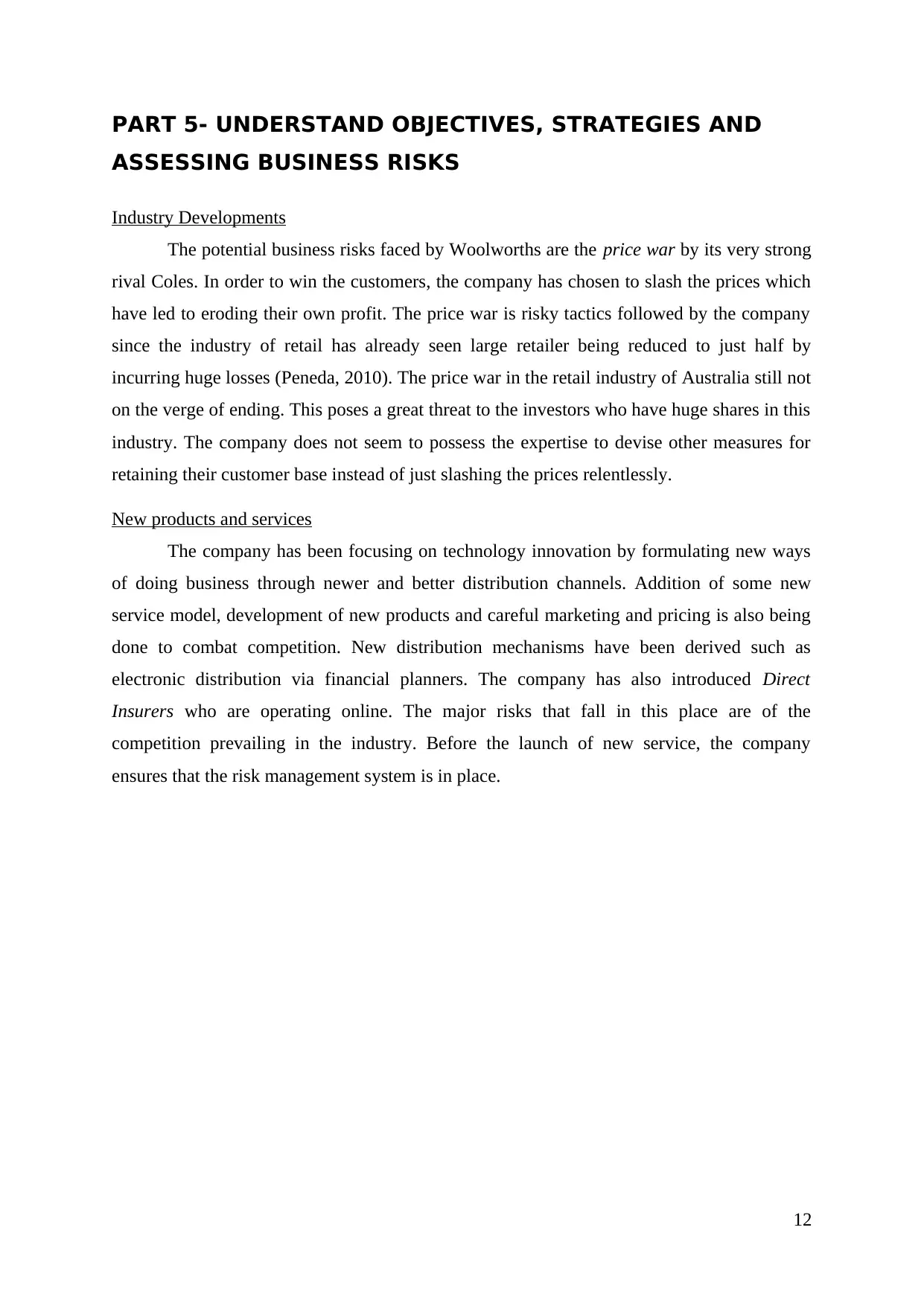
PART 5- UNDERSTAND OBJECTIVES, STRATEGIES AND
ASSESSING BUSINESS RISKS
Industry Developments
The potential business risks faced by Woolworths are the price war by its very strong
rival Coles. In order to win the customers, the company has chosen to slash the prices which
have led to eroding their own profit. The price war is risky tactics followed by the company
since the industry of retail has already seen large retailer being reduced to just half by
incurring huge losses (Peneda, 2010). The price war in the retail industry of Australia still not
on the verge of ending. This poses a great threat to the investors who have huge shares in this
industry. The company does not seem to possess the expertise to devise other measures for
retaining their customer base instead of just slashing the prices relentlessly.
New products and services
The company has been focusing on technology innovation by formulating new ways
of doing business through newer and better distribution channels. Addition of some new
service model, development of new products and careful marketing and pricing is also being
done to combat competition. New distribution mechanisms have been derived such as
electronic distribution via financial planners. The company has also introduced Direct
Insurers who are operating online. The major risks that fall in this place are of the
competition prevailing in the industry. Before the launch of new service, the company
ensures that the risk management system is in place.
12
ASSESSING BUSINESS RISKS
Industry Developments
The potential business risks faced by Woolworths are the price war by its very strong
rival Coles. In order to win the customers, the company has chosen to slash the prices which
have led to eroding their own profit. The price war is risky tactics followed by the company
since the industry of retail has already seen large retailer being reduced to just half by
incurring huge losses (Peneda, 2010). The price war in the retail industry of Australia still not
on the verge of ending. This poses a great threat to the investors who have huge shares in this
industry. The company does not seem to possess the expertise to devise other measures for
retaining their customer base instead of just slashing the prices relentlessly.
New products and services
The company has been focusing on technology innovation by formulating new ways
of doing business through newer and better distribution channels. Addition of some new
service model, development of new products and careful marketing and pricing is also being
done to combat competition. New distribution mechanisms have been derived such as
electronic distribution via financial planners. The company has also introduced Direct
Insurers who are operating online. The major risks that fall in this place are of the
competition prevailing in the industry. Before the launch of new service, the company
ensures that the risk management system is in place.
12
⊘ This is a preview!⊘
Do you want full access?
Subscribe today to unlock all pages.

Trusted by 1+ million students worldwide
1 out of 19
Related Documents
Your All-in-One AI-Powered Toolkit for Academic Success.
+13062052269
info@desklib.com
Available 24*7 on WhatsApp / Email
![[object Object]](/_next/static/media/star-bottom.7253800d.svg)
Unlock your academic potential
Copyright © 2020–2025 A2Z Services. All Rights Reserved. Developed and managed by ZUCOL.





